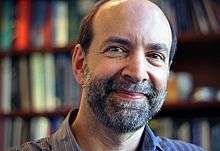Tim Stearns
Tim Stearns (born 1961 in Huntington, New York) is an American biologist, and is the Frank Lee and Carol Hall Professor in the Department of Biology at Stanford University, with appointments in the Department of Genetics and the Cancer Center in the Stanford Medical School. He is the chairman of the Department of Biology, and is an HHMI Professor. Stearns is also a member of JASON, a scientific advisory group, and is an affiliated faculty member of the Stanford Center for International Security and Cooperation. He has served on the editorial boards of The Journal of Cell Biology, Genetics and Molecular Biology of the Cell.
Tim Stearns | |
|---|---|
 Stearns in 2012 | |
| Born | August 8, 1961 |
| Alma mater | |
| Awards | HHMI Professor, Searle Scholar |
| Scientific career | |
| Fields |
|
| Institutions | |
| Thesis | Genetic analysis of the yeast microtubule cytoskeleton (1988) |
| Doctoral advisor | David Botstein |
| Other academic advisors | Marc Kirschner |
| Website | |
Education
Stearns received his B.S. in Genetics from Cornell University and did his undergraduate thesis work in the lab of Tom Fox on nuclear control of mitochondrial function in yeast. He received his Ph.D. in Biology from the Massachusetts Institute of Technology. His Ph.D. advisor at MIT was David Botstein, and the title of his thesis was "Genetic analysis of the yeast microtubule cytoskeleton." Stearns' thesis identified exceptions to the genetic complementation test that were useful for defining genetic interactions and for the first time used the term "synthetic lethality" in the modern sense of two non-lethal mutations resulting in lethality in the double mutant.[1] Stearns credits Botstein with instilling in him a commitment to teaching, and the belief that teaching and research go hand-in-hand.[2]
Professional career
Stearns is known for his work on problems in cell biology and developmental biology, with a focus on the structure and function of the centrosome and cilium of eukaryotic cells. He was a Helen Hay Whitney postdoctoral fellow with Marc Kirschner at UCSF, where he published work on gamma-tubulin[3] and in vitro reconstitution of the centrosome.[4] Stearns has been a faculty member in the Department of Biology at Stanford since 1993. His major research accomplishments include the identification and characterization of new members of the tubulin superfamily of proteins,[5][6][7] elucidation of mechanisms of centrosome duplication,[8][9][10] and identification of properties of the primary cilium.[11][12]
Stearns has also been active in undergraduate and graduate education, being named an HHMI Professor in 2002,[13] and has chaired the Education committees of the American Society for Cell Biology and the Genetics Society of America. He created a pre-grad program at Stanford to train the next generation of leaders in biology research through close interaction with faculty members in course work, research and advising.[14] Stearns taught the Yeast Genetics course at Cold Spring Harbor Laboratory, and has also taught laboratory workshops in South Africa, Chile, Ghana,[15] and Tanzania.[16]
Stearns is an advisor to the US government on science and technology matters. He was a member of the Defense Science Study Group, and is a current member of JASON,[17] an independent scientific advisory group to the US that provides expertise on problems related to national security.
Personal life
Stearns and his wife live near Stanford University and tend a fruit tree orchard[18] originally planted by John Hensill, former dean of Natural Sciences at San Francisco State University, and a founder of the Redwood City Farmers Market.[19] Stearns is an accomplished musician, and student of American traditional music and early jazz.[20][21]
References
- Stearns, T. and Botstein, D. "Unlinked noncomplementation: isolation of new conditional-lethal mutations in each of the tubulin genes of Saccharomyces cerevisiae" Genetics (1988) 119:249-260.
- ASCB Profile - Tim Stearns
- Stearns, T., Evans, L. and Kirschner, M. "Gamma-tubulin is a highly conserved component of the centrosome" Cell (1990) 65:825-836
- Stearns, T. and Kirschner, M. "In vitro reconstitution of centrosome assembly and function: the central role of gamma-tubulin" Cell (1994) 76:623-637
- Chang, P. and Stearns, T. "Delta-tubulin and epsilon-tubulin: two new human centrosomal tubulins reveal new aspects of centrosome structure and function" Nature Cell Biology (2000) 2:30-35
- Chang, P., Giddings, T.H., Winey, M. and Stearns T. "Epsilon-tubulin is required for centriole duplication and microtubule organization" Nature Cell Biol (2003) 5:71-76
- Turk, E., Wills, A.A., Kwon, T., Sedzinski, J., Wallingford, J.B. and Stearns, T. (2015) "Zeta-Tubulin Is a Member of a Conserved Tubulin Module and Is a Component of the Centriolar Basal Foot in Multiciliated Cells" Current Biol (2015) 25:2177-2183
- Lacey, K.R., Jackson, P.K. and Stearns, T. "Cyclin-dependent kinase control of centrosome duplication" Proc Natl Acad Sci (1999) 96:2817-2822
- Wong, C. and Stearns, T. "Centrosome number is controlled by a centrosome-intrinsic block to reduplication" Nature Cell Biol (2003) 5:539-544
- Tsou, M.F. and Stearns, T. "Mechanism limiting centrosome duplication to once per cell cycle" Nature (2006) 442:947-951
- Anderson, C.T. and Stearns, T. "Centriole age underlies asynchronous primary cilium growth in mammalian cells" Current Biol (2009) 19:1498-1502
- Mahjoub, M.R. and Stearns, T. "Supernumerary centrosomes nucleate extra cilia and compromise primary cilium signaling" Current Biol (2012) 22:1628-1634
- "Tim Stearns".
- "His Students Are Pre-Grads".
- http://www.ascb.org/under-a-microscope-in-ghana-the-fifth-west-african-regional-workshop/
- http://web.stanford.edu/group/stearnslab/papers/ascbworkshop.pdf
- "LittleSis: JASON advisory group".
- http://www.ascb.org/files/0605profile.pdf
- "Newsletters of the SFSU College of Science & Engineering Alumni Chapter".
- http://www.ascb.org/files/0605profile.pdf
- https://www.youtube.com/watch?v=vqOAm2xjrLU